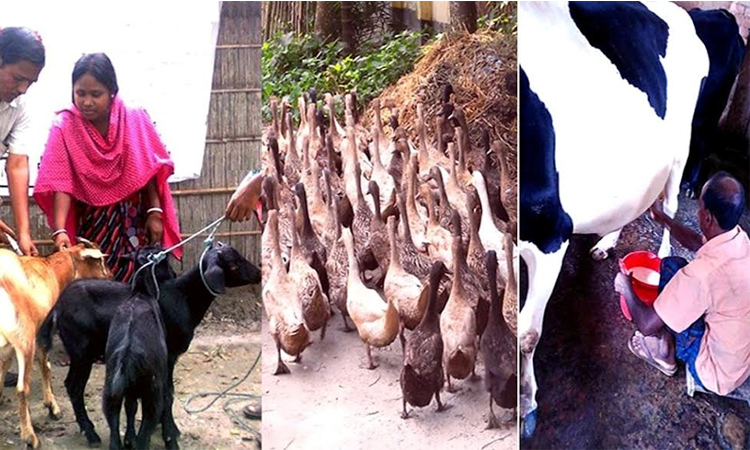News Flash

By Md Mamun Islam
RANGPUR, Nov 23, 2025 (BSS) - In addition to greatly boosting the rural economy, the livestock sector is becoming sustainable by making Rangpur a self-sufficient district in meat, egg and milk production to meet the protein needs of people.
"In the last 15 years (2009-2024), the district has increased production of meat, egg and milk by two to three times and achieved a revolutionary success in the livestock sector," District Livestock Officer Dr Md Abu Sayeed told BSS.
During the period, the Department of Livestock Services provided training to many farm-owners, unemployed male and female youths, small and marginal farmers and landless people on animal husbandry, poultry and grass cultivation.
"Of them, many farmers, entrepreneurs and common people have achieved self-reliance through animal husbandry, poultry and dairy on a commercial basis," he said.
Till 2024, entrepreneurs have set up 7,199 livestock farms, including 3,149 for cows, 702 for goats, 364 for sheep, 587 for layer chickens, 1,735 for broiler chickens, 450 for layer ducks, 212 for pigeons creating jobs of over 40,000 people in the district.
Besides, five parent-stock (broiler) farms, 11 parent-stock (layer) farms, four hatchery (layer) farms and two hatchery (broiler) farms have been established.
In 2024, farmers produced 2.13 lakh metric tonnes of meat against the demand of 1.40 lakh metric tonnes for the 32 lakh population of Rangpur district.
However, the production of meat stood at only 0.88 lakh metric tonnes in the district in 2009.
Similarly, farmers produced 45.67 crore pieces of eggs against the demand of 33.28 crore eggs for 32 lakh people of the district in 2024.
However, the egg production stood at only 17.50 crore pieces in 2009 in all eight upazilas of the district.
In the same way, farmers produced 2.10 lakh metric tonnes of milk in 2024 against the production of 1.79 lakh metric tonnes of milk in 2009 in the district.
"There were 15,66,102 cows, 47,943 sheep, 2,279 buffalos, 10,33,393 goats, 10,71,109 ducks, 22,75,4147 chickens at family levels, 11,91,845 commercial layer chickens and 15,03,325 broiler chickens in 2024 in the district," Dr Md Abu Sayeed said.
Every year, the production and number of cows, buffaloes, goats, ducks, and chickens are increasing at the household and farm levels, making many people self-reliant and contributing greatly to boosting the rural economy across the district, he added.
Talking to BSS, couple Habibur Rahman and Monwara Khatun of village Chhatas Chawrabari under Kawnia upazila said they began their journey with rearing only one cow in 2001.
Currently, they have 18 cows which give 200 liters of milk daily and five pregnant cows that will give birth to heifers and produce milk soon.
They also produce 150 metric tonnes of vermin composts annually, have 32 black Bengal goats and their 33 turkey hens give eggs and they already produced 900 turkey chicks.
"The total value of our livestock resources may be around Taka 70-lakh," said Rahman, adding that they have employed eight workers permanently who get a monthly salary.
Youth Mahmudul Hasan from Faridabad Daktarpara village in Taraganj upazila of Rangpur has set a shining example of success by changing fate through establishing a dairy farm 12 years ago.
He has established 'Mahmudul Dairy Farm' in his backyard as a cow milk production enterprise and employed four people here.
After selling 75 bullocks and cows so far, he has 20 cows on his farm, including 10 milk-giving ones. He produces 70 to 80 liters of milk per day now.
Mahmudul said, "I bought two foreign dairy cows in February 2014. After a few months of raising them, both cows gave birth to one calf each and each cow started giving 10 to 12 liters of milk daily."
"My dairy farm is now running in profit because I got back the Taka 15 lakh I invested earlier. Everything about my dairy farm is now a bonus for me," said Mahmudul.
Similarly, housewife Aktari Khanam from Jummapara village in Taraganj upazila, and Shahinul Alam Bakul, a young man from Moyenpur village in Mithapukur upazila, have become self-sufficient by raising cows on their respective farms.